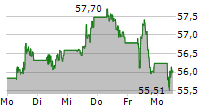
By Peter Tavernise
Do you feel a bit lost when people refer to certain environmental sustainability topics and aren't sure where to start when it comes to learning more? Sustainability 101 is a blog series that you can turn to for information about different environmental terms that may come up at work, during discussions with friends, and even at your annual holiday gathering.
NORTHAMPTON, MA / ACCESSWIRE / June 11, 2024 / "Biodiversity forms the web of life that we depend on for so many things - food, water, medicine, a stable climate, economic growth, among others. Over half of global GDP is dependent on nature. More than 1 billion people rely on forests for their livelihoods. And land and the ocean absorb more than half of all carbon emissions."
- United Nations: Biodiversity - our strongest natural defense against climate change
When it comes to the health of the planet, resilient ecosystems play a critical role. Resilient ecosystems protect the environment and help support the stability and security of human communities.
But what makes an ecosystem resilient and why is it essential for our future?
Resilient ecosystems
A common view of resilient ecosystems is the ability to withstand, recover from, and adapt to changes or shocks from natural events, such as earthquakes, or from human-made causes, such as climate change, pollution, or deforestation.
As the world deals with ongoing changes, the term "resilient ecosystems" is becoming a more frequently discussed topic. But more than a buzzword, it's an increasingly important strategic approach to sustainability. A wider perspective of resilience we can look at in this context includes:
- Ecosystems that are able to adapt, survive, and thrive regardless of the disturbances they face.
- Providing essential services that support life on Earth-such as purifying water and air, supporting agriculture, maintaining biodiversity, and protecting against natural disasters.
Ecosystems have varying degrees of resilience depending on factors such as the variety and interconnectedness of species within the ecosystem, weather patterns, and temperature levels. We find examples of naturally resilient ecosystems now becoming strained, from coral reefs to lakes and forests.
As we have seen, ecosystem resilience can be negatively impacted by things like climate change and human-driven deforestation. For example, due to encroachment by human activities, it's estimated that the Amazon rainforest has lost more than three-quarters of its resilience, making it more vulnerable to extreme events such as droughts. These types of trends are critical to address, given the interwoven balance of carbon stores, biodiversity, and human activity.
Interconnection - At the heart of establishing resilience
From this wider view, at the core of resilient ecosystems is interconnection-not just within the ecological community but also among individuals and societies.
This means moving beyond mere transactions with nature to fostering meaningful relationships with our environment and each other. Building connections and fostering unified responses are crucial for resilience. It's about creating a world where we support our ecosystems as much as they support us.
The United Nations describes its Sustainable Development Goals (SDGs) as "integrated and indivisible," recognizing that sustainability efforts must build upon the connections between individuals, communities, and the environment. The SDGs emphasize that progress in one area amplifies the potential in others.
For instance, improving the health of our ecosystems directly supports goals related to health, water, and even economic growth. Recognizing the interdependence of these goals can help prioritize actions that offer the most significant mutual benefits.
When natural ecosystems are protected and preserved, that translates to benefits for the community-such as the ability to earn a living, resources to build schools, access to clean drinking water, and reduction of disease.
How Cisco is advancing resilient ecosystems
Investing in resilient ecosystems is one of the three key priorities of The Plan for Possible, our next-generation environmental sustainability strategy. We believe it is critical to help humans and nature navigate a changing climate by investing in regenerative technologies, workforces, and nature itself.
The Cisco Foundation's social investment strategy is closely aligned to this priority, particularly through its 10-year, $100 million climate impact initiative. The Cisco Foundation is supporting resilient ecosystems through both grants and impact investments, directly helping communities cultivate approaches for a regenerative economy, launching climate-focused companies, as well as supporting educational initiatives to help people take effective climate action.
Beyond the Foundation's climate impact initiative, the Foundation also supports community and ecosystem resilience through investments in other sectors, including Crisis Response and Critical Human Needs, Education, and Economic Empowerment. For example, in 2021, NESsT launched the Amazonia Tech Portfolio with support from Cisco that addresses regenerative forest conservation by supporting climate-smart solutions that grow sustainable value chains while improving livelihoods in the Amazon basin.
Climate adaption and resilience
Cisco's nonprofit partner Mercy Corps provides an inspiring example of building resilient ecosystems. Mercy Corps partners with communities around the world to help them adapt to their changing environment and innovate to improve their livelihoods-collaborating with partners large and small, global and local.
Our recent five-year Technology for Impact partnership with Mercy Corp reached more than 13 million people across 45 countries, and it has also influenced the broader humanitarian and development sector. Now we have a new partnership that focuses on fostering climate adaptation and resilience.
In the Horn of Africa, where over 20 million people's lives and livelihoods are being threatened by drought, Cisco is working with Mercy Corps to support pastoralist farmers who have been severely impacted by the drought in Northeast Kenya. You can learn more about our partnership in the video above.
Building community skills for resilience
Developing a workforce with the right skills is an important component of building resilient ecosystems and supporting transitions to clean energy. The Cisco Foundation supports various organizations that are advancing environmental education and initiatives, including DOT (Digital Opportunity Trust), which supports a youth-led response to the global climate challenge in regions such as Lebanon and Tanzania, and the Pachamama Alliance which focuses on developing skills for local community action and climate justice.
Communities leading the way in resilient ecosystems are those that emphasize a deep connection, working to restore our relationships with the Earth, each other, and ourselves.
By understanding and supporting resilient ecosystems, we can empower vulnerable communities and co-create opportunities for more sustainable and equitable development.
As we continue to face environmental challenges, the need for robust, resilient ecosystems has never been greater. It's time to foster a broader climate and environmental movement, one that welcomes new ideas, people, and inventive connections.
Together, we can build a resilient future where both people and the planet thrive. Want to learn more and get involved? Check out our Climate Grants and Investments page, for more information.
View original content here.
View additional multimedia and more ESG storytelling from Cisco Systems Inc. on 3blmedia.com.
Contact Info:
Spokesperson: Cisco Systems Inc.
Website: https://www.3blmedia.com/profiles/cisco-systems-inc
Email: info@3blmedia.com
SOURCE: Cisco Systems Inc.
View the original press release on accesswire.com




